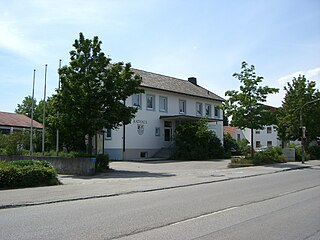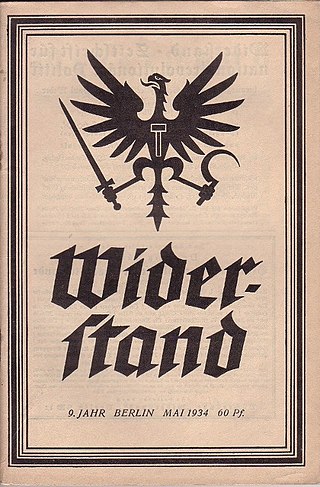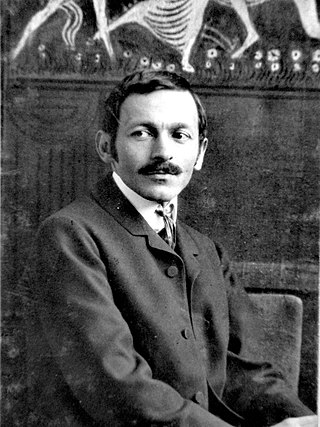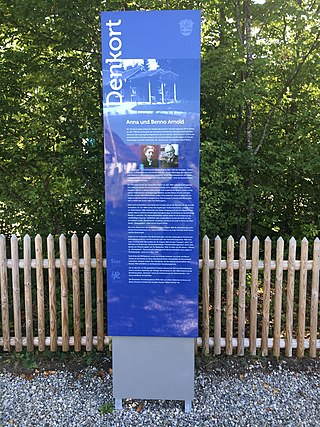External links
- Literature by and about Ludwig Eiber in the German National Library catalogue
- Universität Augsburg: Publikationsliste von Ludwig Eiber
- 7. Dachauer Symposium zur Zeitgeschichte - Dachauer Prozesse
Ludwig Eiber (born 1945) is a German historian and author. He is widely acknowledged as an expert on the post-World War II Allied war crimes trials of the Nazis. In particular, he has expertise in the Dachau trials.
Eiber studied History at the University of Munich and received his doctorate there in 1978 with his dissertation on the experience of slave workers under the Nazi regime. In particular, he focused on the experience of textile and porcelain workers in the northeastern Upper Franconia, 1933–1939. Then he was at the Institute of Contemporary History.
From 1980 to 1988 he headed the Neuengamme concentration camp memorial. [1] He then did research until 1991 at the Hamburg Foundation for Social History of the 20th century, on the Hamburg workers' resistance (1933-1939) and in connection to Leibniz University Hannover and the emigration of Social Democrats to Great Britain (1940-1945).
From 1996 he was a research associate at the House of Bavarian History and completed his Habilitation in 1997 at the University of Hamburg: Arbeiter und Arbeiterbewegung in der Hansestadt Hamburg in den Jahren 1929–1939: Werftarbeiter, Hafenarbeiter und Seeleute; Konformität, Opposition, Widerstand. From 1998 to 2003 he was project leader in the revision of the exhibition at the Dachau Concentration Camp. In addition, he served as Associate Professor of Modern and Contemporary History at the Faculty of Philology and History from 2000 at University of Augsburg. In 2004 he took over the management of the House of Bavarian History project.
From 2005, he prepared the national exhibition in Zwiesel for 2007. He retired in 2010, [1] and resides in Giesing, a Munich suburb. [2]
Eiber has published the following: [3]
The Mauthausen-Gusen camp trials were a set of trials of SS concentration camp personnel following World War II, heard by an American military government court at Dachau. Between March 29 and May 13, 1946, and then from August 6 to August 21, 1947, a total of 69 former camp personnel were tried. Among them were some of the former guards at the Mauthausen-Gusen concentration camp system and August Eigruber, a former Gauleiter of Upper Austria.

Markt Indersdorf is a municipality in the district of Dachau in Bavaria in Germany.

Fahrenzhausen is a municipality located on the river Amper in the district of Freising in Bavaria in Germany. The town is about 30 Kilometers north of Munich.

The Esterwegen concentration camp near Esterwegen was an early Nazi concentration camp within a series of camps first established in the Emsland district of Germany. It was established in the summer of 1933 as a concentration camp for 2000 so-called political Schutzhäftlinge and was for a time the second largest concentration camp after Dachau. The camp was closed in summer of 1936. Thereafter, until 1945 it was used as a prison camp. Political prisoners and so-called Nacht und Nebel prisoners were also held there. After the war ended, Esterwegen served as a British internment camp, as a prison, and, until 2000, as a depot for the German Army.

Dr. Herbert Michaelis was a German lawyer and Communist, and a member of the German Resistance during the Third Reich.

Rudolf Querner was a German SS functionary during the Nazi era. He served as the Higher SS and Police Leader in Austria and Germany and was responsible for the evacuations and death marches from concentration camps at the end of the war. Arrested by the Allied authorities, he committed suicide in prison.

The Dora Trial, also the "Dora"-Nordhausen or Dachau Dora Proceeding was a war crimes trial conducted by the United States Army in the aftermath of the collapse of the Third Reich. It took place between August 7 and December 30, 1947, on the site of the former Dachau concentration camp, Germany.

Franz Stärfl, alias Xaver Stärfel, alias Franz Stofel, was a Nazi German SS-Hauptscharführer and camp commander of the Kleinbodungen subcamp of Mittelbau-Dora during World War II. Arrested by the Allies and convicted of war crimes in the Belsen Trial, Stärfl was executed by hanging at Hamelin prison in 1945.
As part of the "Arbeitsscheu Reich"(work-shy Reich) in April and in June 1938 in two waves of arrests more than 10,000 men as so-called "black triangle anti-social elements" to concentration camps. During the so-called June-action were also arrested about 2,500 Jews who had received previous convictions for varied reasons.

The Buchenwald trial or United States of America vs. Josias Prince of Waldeck et al. was a war crime trial conducted by the United States Army as a court-martial in Dachau, then part of the American occupation zone. It took place from April 11 to August 14, 1947 in the internment camp of Dachau, where the former Dachau concentration camp had been located until late April 1945. In this trial, 31 people were indicted for war crimes related to the Buchenwald concentration camp and its satellite camps, all of whom were convicted. The Buchenwald trial was part of the Dachau trials, which were held between 1945 and 1948.

Widerstand. Zeitschrift für nationalrevolutionäre Politik was a monthly magazine established in Germany in 1926 to advocate national-revolutionary idea. It was published in Berlin, under the editorship of Ernst Niekisch. Prominent contributors included Ernst Jünger, Friedrich Georg Jünger, A. Paul Weber, August Winnig, and Joseph E. Drexel. The newspaper was shut down in December 1934. After a time in the underground, Niekisch was arrested and held in Nazi concentration camps from 1937 to 1945.
Susanne Heim is a German political scientist and historian of National Socialism, the Holocaust and international refugee policy.

Ignatius Taschner, also known as Ignaz Taschner, was a German sculptor, medalist, graphic designer and illustrator.

Norbert Niemann is a German writer.
Engelbert Valentin Niedermeyer was an SS operative with the position of block leader in the Dachau concentration camp. After being tried and convicted in a court of law, and with special consideration given to his treatment of the inmates, on December 13, 1945 he was sentenced to die by hanging. Following due process, the sentence was carried out on May 28, 1946 in Landsberg. The execution was filmed by U.S. military personnel, who recorded Niedermeyer's hanging, along with a coffin marked "Niedermeyer Engelbert."

Approximately 30,000 Jews in Germany and Austria were deported within the region or the country after the Kristallnacht of 9/10 November 1938. They were deported to the concentration camps Buchenwald, Dachau and Sachsenhausen by the NSDAP organizations and the police in the days after the pogrom. This put pressure on the deportees and their relatives in order to speed up the only seemingly voluntary emigration from their homeland and to "Aryanize" Jewish assets. The vast majority of the detainees were released by the beginning of 1939. Around 500 Jews were murdered, committed suicide or died as a result of ill-treatment and refused medical treatment in the concentration camps.
Edith Raim is a German historian who studies the Nazi era. She grew up in Landsberg am Lech and first became interested in the topic after watching Holocaust as a child. Being a student of Anton Posset she started under his guidance the historical reappraisal of the concentration camp complex Kaufering, a sub-camp of Dachau concentration camp. Her 1991 dissertation at Ludwig Maximilian University of Munich was titled Die Dachauer KZ-Aussenkommandos Kaufering und Mühldorf: Rüstungsbauten und Zwangsarbeit im letzten Kriegsjahr 1944/45 and concerned the Dachau subcamps of Kaufering and Mühldorf.

The Dachau camp trial was the first mass trial of the Dachau trials, a series of trials against war criminals held by the United States Army on the premises of the Dachau concentration camp. The main trial took place from 15 November to 13 December 1945. Forty people were charged with war crimes in connection with the Dachau concentration camp and its subcamps. The trial ended with 40 convictions, including 36 death sentences, of which 28 were carried out. The official name of the case was United States of America vs. Martin Gottfried Weiss et al. - Case 000-50-2. The main trial served as a "parent case" for 123 subsequent cases. In the subsequent trials, all crimes that were established in the main trial were taken as proven, significantly shortening their duration relative to the parent case. The Dachau trials consisted of 6 total parent trials, each with their own subcases, and were held between 1945 and 1948. In total, there were 489 Dachau trials, of which 394 were held within the confines of the camp itself.

Dachau is a 72-page investigation report by the 7th US Army on Dachau, one of the concentration camps established by Nazi Germany. The report details the mass murder and mass atrocities committed at Dachau by the SS and other personnel. Following the liberation of the camp by the 7th US Army on 29 April 1945, the report was prepared during the following one or two weeks and published in May. In addition to a preface, the report contains three independent reports which partly overlap thematically. Although it contains some errors, the report is considered one of the first studies on the Nazi concentration camps.

Benno Arnold was a German Jewish textile industry entrepreneur in Augsburg who was murdered in the Holocaust.